In the third chapter of Welcome to Writing Workshop, “A Community of Writers: The Ingredients for Building and Sustaining Success,” Lynne Dorfman and I wrote:
Building a writing community starts in September, but sustaining the community is a yearlong effort (2016, 41).
Establishing practical routines with predictable procedures is one of the most important things teachers can do to help the writing community thrive from the start. Before the school year begins, think about the kinds of routines you’ll want to establish for all aspects of the writing workshop. Once you think of the most important ones, create a plan for how you’ll teach students the routines. Rather than telling kids “This is how it’s done,” you can engage students with new routines by using a quick-paced and efficient process, such as interactive modeling, to help routines stick.
You might be wondering why interactive modeling is better than traditional modeling. Here’s why (in a nutshell):
The distinctive steps of Interactive Modeling incorporate key elements of effective teaching: modeling positive behaviors, engaging students in active learning, and immediately assessing their understanding. Research shows that when we teach in this way, children achieve greater, faster, and longer-lasting success in meeting expectations and mastering skills.
With Interactive Modeling, children create clear, positive mental images of what is expected of them. They do the noticing themselves, which builds up their powers of observation and their analysis and communication skills. In addition, because they get immediate practice, they gain quicker expertise and stronger mastery of the procedure or skill being taught. (Source: https://www.responsiveclassroom.org/what-interactive-modeling/.)
Check out this past blog post for more on interactive modeling.

Some routines are more important to teach during the first six weeks of school than others. Here are 12 routines I suggest teachers spend time modeling with their students during the first few weeks of school so their workshops run efficiently and effectively.
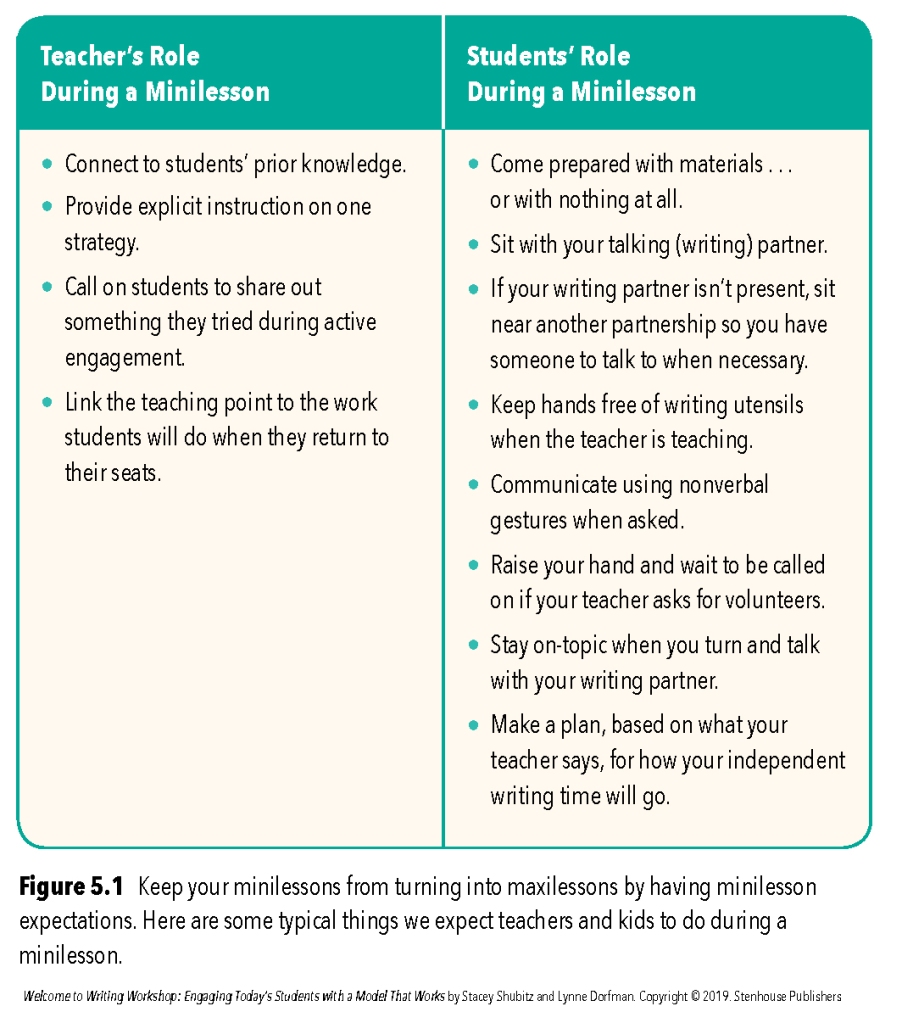
- Walking To & From the Meeting Area
- Why It Matters: It’s important to keep kids safe and moving around the classroom in an orderly fashion. Therefore, it’s helpful to practice everything from gathering their materials to pushing their chairs as they transition from one space to the meeting area.
- Bonus Tip: You might also include where to sit in the meeting area when you model this with students.
- Using and Restocking Writing Utensils
- Why It Matters: Whether you’re using pens or pencils (Here’s a great piece by Beth Moore to help you decide which one is better for your workshop!), make sure students don’t have to search for a writing utensil. Teach students to throw away dried-up markers and pens, rather than asking you for permission to pitch them. For pencils, you might have a couple of “pencil sharpeners” on your classroom job list so that there are always sharp pencils for students to use.
- Bonus Tip: If you’re using pencils, then you can provide a bin that houses sharpened pencils so students don’t need to disrupt the class during independent writing time with the grinding of a pencil sharpener.
- Caring for Communal Supplies
- Why It Matters: If your students will share communal supplies, they will need to know where the supplies are, how to use them responsibly, and how to restock the supplies when they’re empty.
- Bonus Tip: Consider having students sort and label supplies at the beginning of the school year so they feel a sense of ownership over the communal supplies.
- Asking for Permission to Leave the Classroom
- Why It Matters: Teach your students to ask permission to leave the classroom, without speaking, so you can stay focused on your students during 1:1 writing conferences and small group lessons.
- Bonus Tip: Options for leaving the classroom to use the water fountain or bathroom include: a) a pass system where students grab a physical pass on a hook before leaving the room, b) using sign language to ask for permission, or c) a sign out system — on paper or with an iPad — without asking for permission to leave the room.
- Getting Help from a Teacher or a Peer
- Why It Matters: As part of a writing community, it’s important for students to begin to rely on each other, rather than just you, when they need help. Encourage students to ask up to three peers before seeking you out for assistance. If a student cannot get help from a peer, then you can encourage them to write you a note to ask for help.
- Bonus Tip: If a student must wait for your assistance, then teach them to listen-in on a conference, rather than interrupting. In addition, Betsy Hubbard encourages students who can’t wait to rest their hand on her shoulder. This communicates to Betsy a student has a non-emergent but important message while allowing her to continue to work with her group or 1:1 writing conference until a natural pause presents itself. It honors all involved and comforts students who may otherwise not inform her of an issue or concern that needs an adult.
- Staying Attentive for a Minilesson
- Why It Matters: Students must understand their role and their teacher’s role during the minilesson so they know what their responsibilities are during that time. If students understand they need to try to stay focused for a finite amount of time, then it makes it easier to stay focused.
- Bonus Tip: Help students understand that no one leaves the meeting area during a minilesson unless it’s a true emergency. Therefore, create a time period for students to use the bathroom prior to the beginning of writing workshop so that using the bathroom doesn’t become a frequent emergency for students.
- Turning and Talking
- Why It Matters: All students need to know who their writing partner is and how to turn and talk with them. Students need to understand how to sit knee-to-knee and eye-to-eye, how to speak respectfully, and how to stay on-topic.
- Bonus Tip: Teach students to join another partnership if their writing partner is absent.
- Making Plans
- Why It Matters: Students are more likely to stay focused for the duration of independent writing time if they have planned how they will use their time. In primary grades, you can teach students to make oral plans. In upper grades, students can create a written plan box that will serve as a to-do list for their workshop time.
- Bonus Tip: Don’t give up on having students create plans. Planning is new to many kids so it will take at least two weeks for kids to get into the groove of making plans. Be patient and stay the course. I promise that you see an increase in student engagement once you implement planning time at the end of each minilesson.
- Turning in Work
- Why It Matters: It’s important to have systems for collecting student work so you don’t have piles of paper and notebooks all over your classroom. You might have two different locations — one for putting away folders and/or notebooks and one for turning in work to you — around you classroom to avoid “traffic jams” in one area.
- Bonus Tip: You might not want to check 30 drafts multiple times during the writing process. Consider checking different students’ work at different points during the writing process.
- Getting Students’ Attention with a Signal
- Why It Matters: It’s important to have a signal to get your writers’ attention to bring them back from partner work or turn and talks.
- Bonus Tip: Have a signal when you want everyone to stop working independently (e.g., My go-to phrase, which I borrowed from Lucy Calkins, is “Writers, may I have your eyes?”) and another phrase to regain attention when the room is noisy (e.g., “Clap once if you hear my voice. {Wait.} Clap twice if you can hear my voice. {Wait.} Clap three times if you can hear my voice.”)
- Dealing with Disruptions
- Why It Matters: Disruptions are common in schools so it’s our job to minimize them. Consider a sign that says, “We’re writing. Please don’t disturb.” to hang on your classroom door. Also, delegate a couple of students each week (on your classroom job chart) to answer the classroom phone so that you don’t have to be interrupted during a writing conference.
- Bonus Tip: Ask your principal if you can take the phone off the hook during minilessons so your teaching time isn’t disrupted. Believe it or not, I’ve witnessed many principals granting this request.
- Using Classroom Resources
- Why It Matters: Mentor texts should be accessible for students during workshop time. In addition, students should know where writing anchor charts are located and should be allowed to access them at any point during the writing workshop.
- Bonus Tip: Take a look at these photos of interactive bulletin boards, created by Melanie Meehan, which help kids access things they need independently during the workshop.
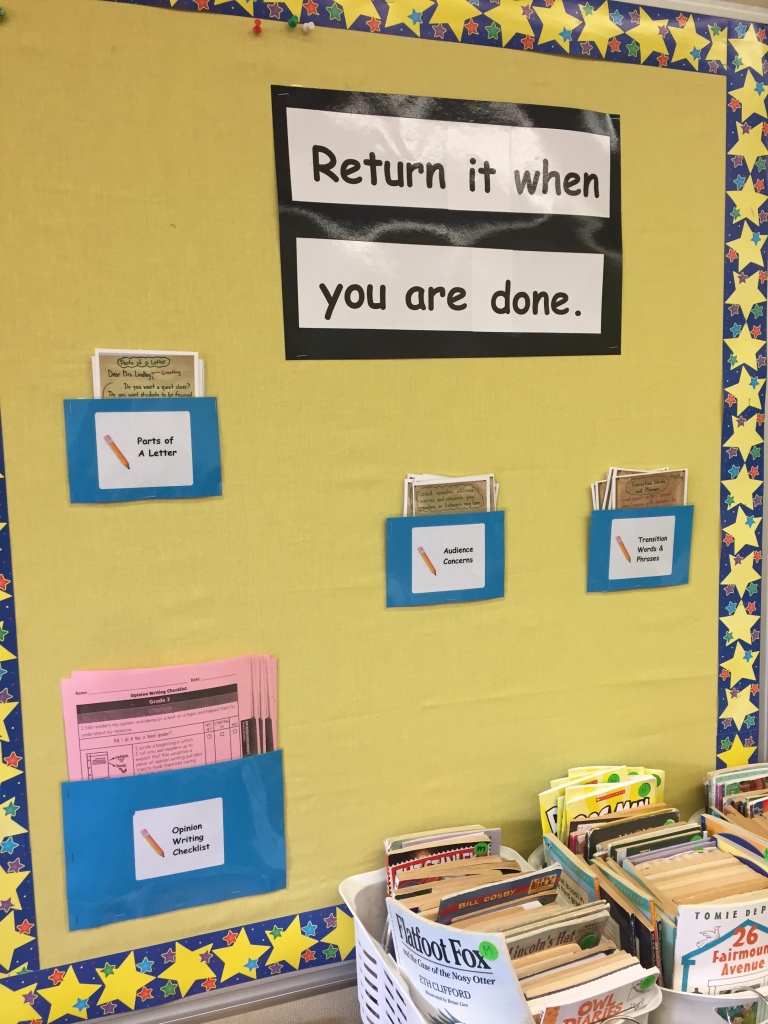
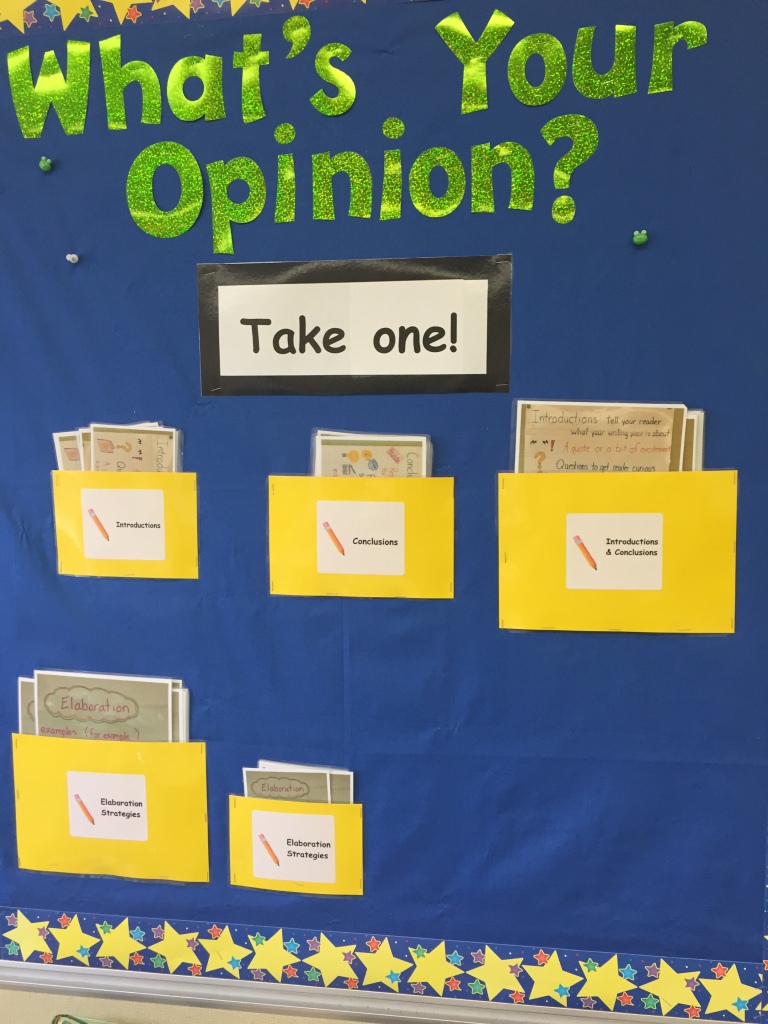

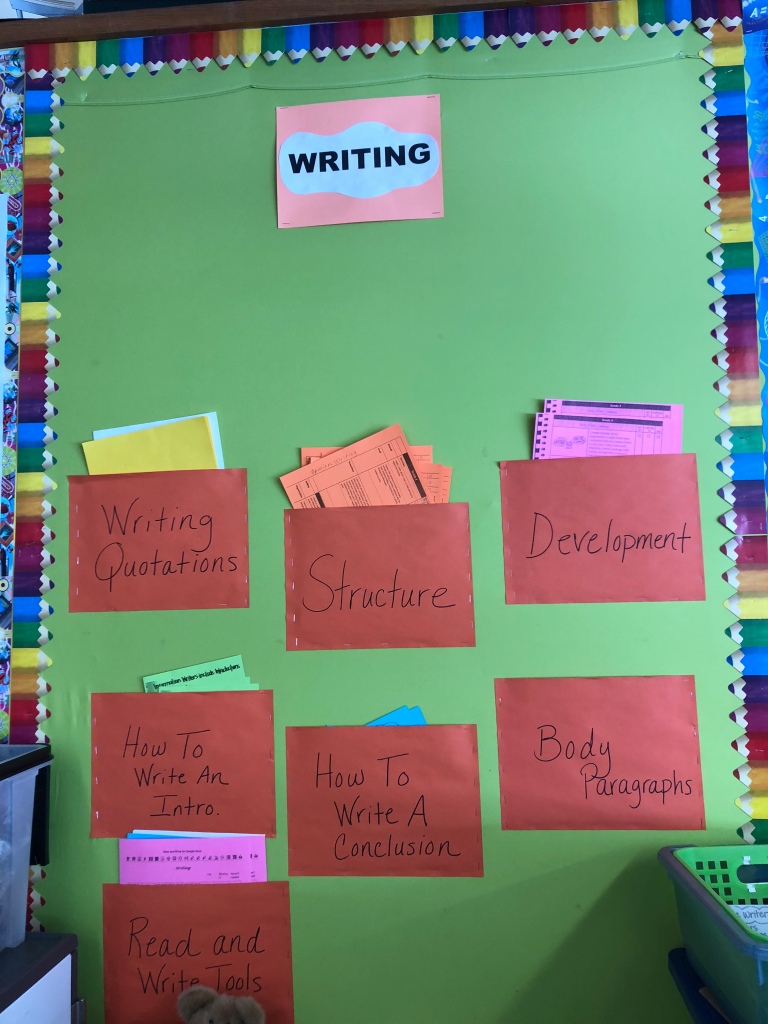
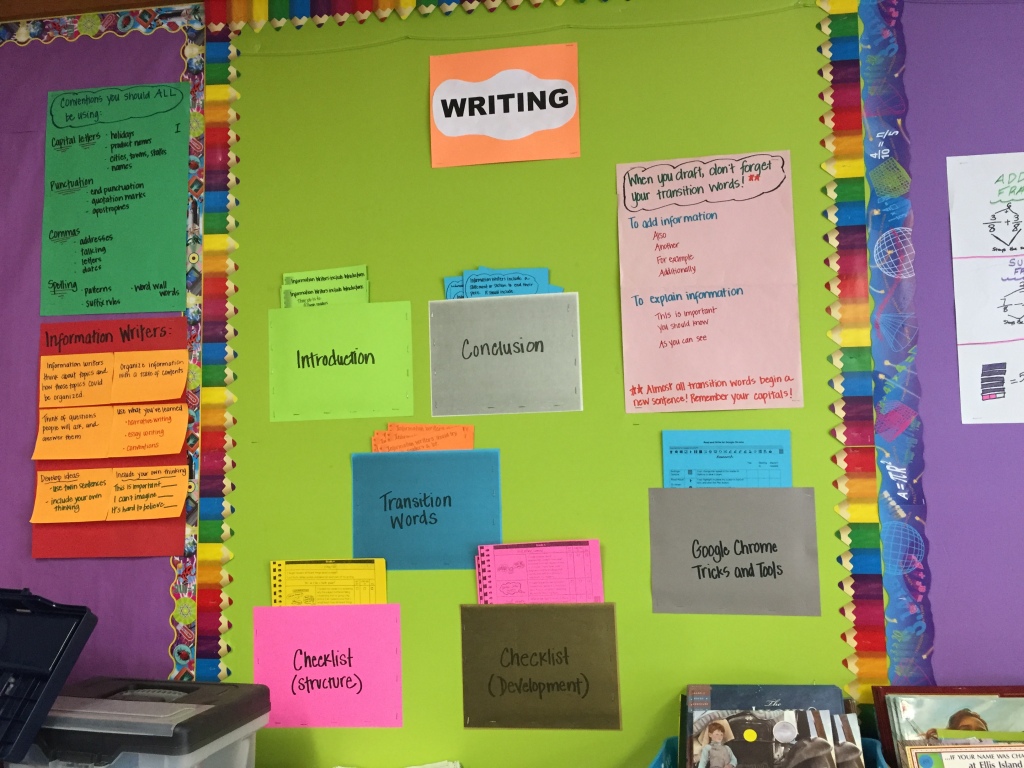
Of course, my list of a dozen routines to teach isn’t exhaustive. However, I intentionally left some things — such as what a child can do to manage distractions if it’s hard for them to focus — off of this list since those are things you can teach kids to do in another subject area.
Don’t be afraid to take the time to teach into routines, especially snow days or before holidays, when students’ attention span might be compromised. Time spent on routines always gets returned to you since a small refresher is what can keep a classroom writing community growing and learning all year long.
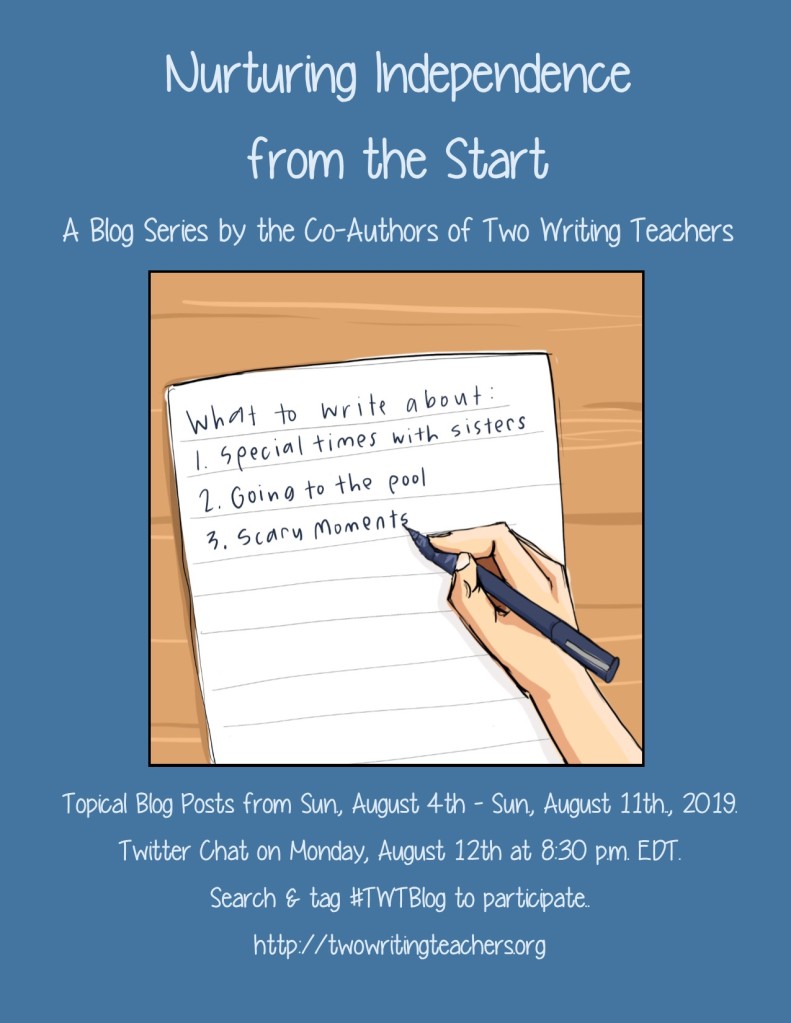
Giveaway Information:
- This giveaway is for a copy of No More “I’m Done!” and No More “How Long Does It Have to Be?” by Jennifer Jacobson. Thanks to Stenhouse Publishers for donating a copy of each of these books — one book for a primary educator and one book for a secondary educator. (You must have a U.S. mailing address to win a print copy of this book.)
- For a chance to win this copy of No More “I’m Done!” or No More “How Long Does It Have to Be?”, please leave a comment about this or any blog post in this blog series by Sunday, August 11th at 6:00 p.m. EDT. BE SURE TO WRITE DOWN THE GRADE LEVEL OR GRADE BAND YOU TEACH SO WE CAN PUT YOU IN THE RUNNING FOR THE BOOK THAT MATCHES THE GRADE BAND YOU TEACH. Betsy Hubbard will use a random number generator to pick the winner’s commenter number. His/her name will be announced in the ICYMI blog post for this series on Monday, August 11th.
- Please leave a valid e-mail address when you post your comment so Betsy can contact you to obtain your mailing address if you win. From there, our contact at Stenhouse will ship the book to you. (NOTE: Your e-mail address will not be published online if you leave it in the e-mail field only.)
- If you are the winner of the book, Betsy will email you with the subject line of TWO WRITING TEACHERS – NO MORE BOOKS within five days of receipt. A new winner will be chosen if a response isn’t received within five days of the giveaway announcement.
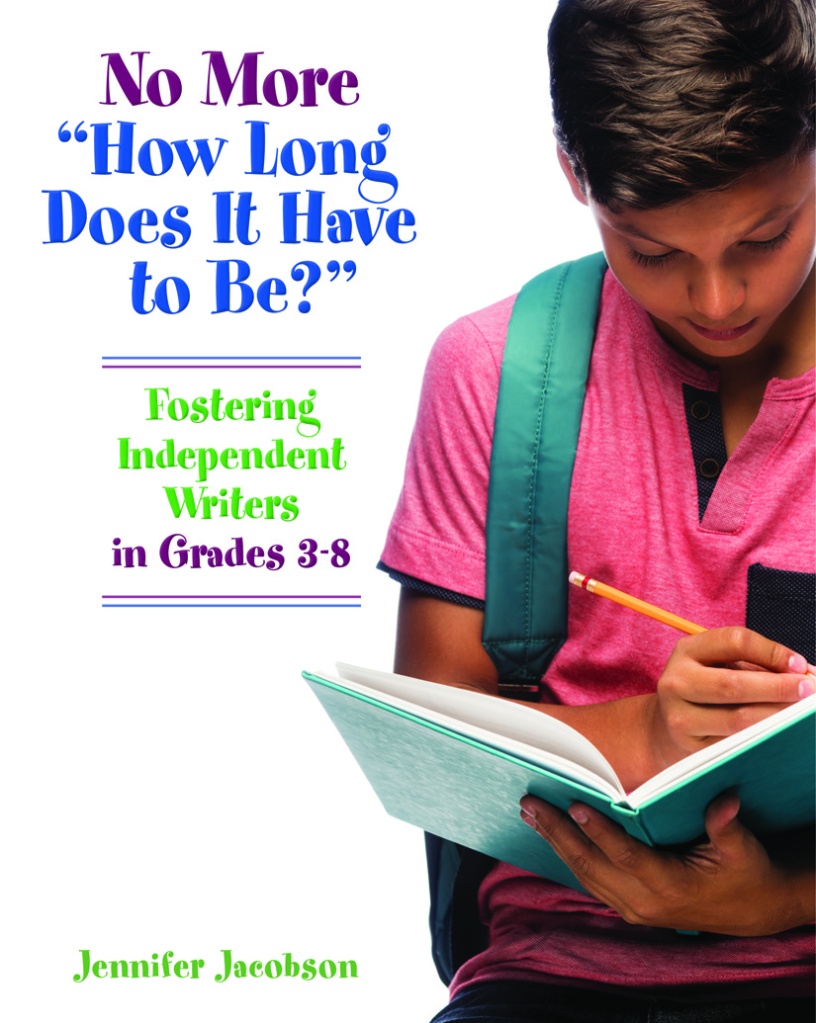



Great list of routines. Observation helps. What makes writing workshop flow? Where does it get “snagged up”? What might help? So many ways to consider how life flows in a classroom! These are such a timely reminder for the beginning of the year! ❤
LikeLiked by 1 person
Thank you so much for these reminders.
So helpful as we get closer to September!
I’m grateful for your blog.
– Loralee (kindergarten teacher)
LikeLiked by 1 person
Thank you for all the clear, concise routines. I’ve already added them to my lesson plans.
I teach first grade and we start in 2 weeks. I love your blog!
LikeLiked by 1 person
This blog series is the most outstanding ever! The inclusion of interactive modeling from Responsive Classroom is the best! Thank you for this!
As a reading specialist in a K-6 elementary school, I will look forward to reading both (or either) of the professional books!
LikeLiked by 1 person
This post is critical for all teachers, novice and veteran! Taking time to plan for and establish strong routines really makes workshop time everyone’s favorite part of the day, I especially love the interactive modeling tips. As a second grade teacher, I will be frequently returning to this post.
LikeLiked by 1 person
Routines are the key to starting EVERY school year!! Perfect ideas & examples! Thank you for sharing! Grades TK-8
LikeLiked by 1 person
Love all of these ideas and the intentionality with which you describe them. Sometimes, it’s easy to get lax in our procedures with the excuse that it takes time away from writing. But the truth is that getting these routines down will free up writing time later on. I tech grade 5.
LikeLiked by 1 person
Hi! Great reminders, thank you. I love the idea about pens vs pencils and will try pens this year. However, you recommend flair pens, but not felt tip. Aren’t they the same? I only know of Papermate’s Felt Tip Flair pens. Are there different kinds (only Papermate came up when I googled it). Thanks! I teach 2nd grade. victoria.serecin@me.com
LikeLike
I’m not 100% sure if they are the same. (I’m about 99% sure they are though.)
LikeLike
Thanks for this great post, chock-full of ideas for starting the year off right!
LikeLiked by 1 person
This is great. I can’t wait to launch my writers’ workshop this year. I plan to model all of these routines to demonstrate how things should look and feel. Thank you.
Stephanie- 5th grade
LikeLiked by 1 person
Wow, Stacey! Thank you for this clear, concise, focused post on routines! I am excited to try using an interactive bulletin board for writing this year – it may end up being a hybrid at the start – with current chart featured and tools alongside – but the seed has been planted and ideas are forming! Thank you, thank you, thank you!
LikeLiked by 1 person
Great post! I teach 4th grade and my email is aimee.randall@mmuusd.org Thank you!
LikeLiked by 1 person
So many great ideas here. These are so important for developing a routine and several are ideas that I have not thought to trouble shoot but are certainly important to establishing a learning/writing environment. Thank you. pflevy70@gmail.com
LikeLike
Oh my goodness, Stacey. What a great blog post for starting the year out right in writing workshop. My kiddos always love this special time of our day but I always feel like it is more chaotic. Solution – Interactive modelling! Thank you! And of course I would love one of Betsy’s books. My email is pstegink@fhps.net
LikeLike
I can’t wait to meet with my fourth graders on September 5th. I feel so excited about teaching writing again. After being the K-5 math specialist for several years, I have to admit that I felt a little “rusty” when I thought about my ELA instructional practice. Thanks to these posts I am gaining more and more confidence about developing a community of writers in the upcoming school year. Special thanks for the tip on interactive modeling!
LikeLike
Great post with just the reminders I need before school starts!
LikeLike
This was great. I needed to be reminded of the steps for setting up writing routines. So important. Also pen vs pencil. Definitely pen because I do photocopy some of their stories. Great article. I teach 2nd grade writing.
LikeLike